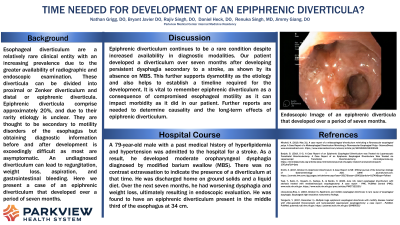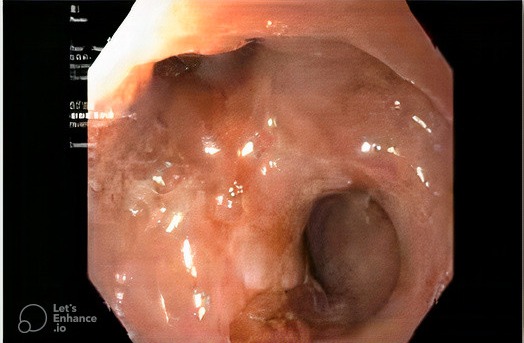Back


Poster Session D - Tuesday Morning
Category: Esophagus
D0219 - Time Needed for Development of an Epiphrenic Diverticula?
Tuesday, October 25, 2022
10:00 AM – 12:00 PM ET
Location: Crown Ballroom

Has Audio
- NG
Nathan Grigg, DO
Parkview Medical Center
Pueblo, CO
Presenting Author(s)
Nathan Grigg, DO, Bryant Javier, DO, Rajiv Singh, MD, Daniel Heck, DO, Renuka Singh, MD, Jimmy Giang, DO
Parkview Medical Center, Pueblo, CO
Introduction: Esophageal diverticulum are a relatively rare clinical entity with an increasing prevalence due to the greater availability of radiographic and endoscopic examination. These diverticula can be divided into proximal or Zenker diverticulum and distal or epiphrenic diverticula. Epiphrenic diverticula comprise approximately 20%, and due to their rarity etiology is unclear. They are thought to be secondary to motility disorders of the esophagus but obtaining diagnostic information before and after development is exceedingly difficult as most are asymptomatic. An undiagnosed diverticulum can lead to regurgitation, weight loss, aspiration, and gastrointestinal bleeding. Here we present a case of an epiphrenic diverticulum that developed over a period of seven months.
Case Description/Methods: A 79-year-old male with a past medical history of hyperlipidemia and hypertension was admitted to the hospital for a stroke. As a result, he developed moderate oropharyngeal dysphagia diagnosed by modified barium swallow (MBS). There was no contrast extravasation to indicate the presence of a diverticulum at that time. He was discharged home on ground solids and a liquid diet. Over the next seven months, he had worsening dysphagia and weight loss, ultimately resulting in endoscopic evaluation. He was found to have an epiphrenic diverticulum present in the middle third of the esophagus at 34 cm.
Discussion: Epiphrenic diverticulum continues to be a rare condition despite increased availability in diagnostic modalities. Our patient developed a diverticulum over seven months after developing persistent dysphagia secondary to a stroke, as shown by its absence on MBS. This further supports dysmotility as the etiology and also helps to establish a timeline required for the development. It is vital to remember epiphrenic diverticulum as a consequence of compromised esophageal motility as it can impact morbidity as it did in our patient. Further reports are needed to determine causality and the long-term effects of epiphrenic diverticulum.

Disclosures:
Nathan Grigg, DO, Bryant Javier, DO, Rajiv Singh, MD, Daniel Heck, DO, Renuka Singh, MD, Jimmy Giang, DO. D0219 - Time Needed for Development of an Epiphrenic Diverticula?, ACG 2022 Annual Scientific Meeting Abstracts. Charlotte, NC: American College of Gastroenterology.
Parkview Medical Center, Pueblo, CO
Introduction: Esophageal diverticulum are a relatively rare clinical entity with an increasing prevalence due to the greater availability of radiographic and endoscopic examination. These diverticula can be divided into proximal or Zenker diverticulum and distal or epiphrenic diverticula. Epiphrenic diverticula comprise approximately 20%, and due to their rarity etiology is unclear. They are thought to be secondary to motility disorders of the esophagus but obtaining diagnostic information before and after development is exceedingly difficult as most are asymptomatic. An undiagnosed diverticulum can lead to regurgitation, weight loss, aspiration, and gastrointestinal bleeding. Here we present a case of an epiphrenic diverticulum that developed over a period of seven months.
Case Description/Methods: A 79-year-old male with a past medical history of hyperlipidemia and hypertension was admitted to the hospital for a stroke. As a result, he developed moderate oropharyngeal dysphagia diagnosed by modified barium swallow (MBS). There was no contrast extravasation to indicate the presence of a diverticulum at that time. He was discharged home on ground solids and a liquid diet. Over the next seven months, he had worsening dysphagia and weight loss, ultimately resulting in endoscopic evaluation. He was found to have an epiphrenic diverticulum present in the middle third of the esophagus at 34 cm.
Discussion: Epiphrenic diverticulum continues to be a rare condition despite increased availability in diagnostic modalities. Our patient developed a diverticulum over seven months after developing persistent dysphagia secondary to a stroke, as shown by its absence on MBS. This further supports dysmotility as the etiology and also helps to establish a timeline required for the development. It is vital to remember epiphrenic diverticulum as a consequence of compromised esophageal motility as it can impact morbidity as it did in our patient. Further reports are needed to determine causality and the long-term effects of epiphrenic diverticulum.

Figure: Endoscopic Image of an epiphrenic diverticula that developed over a period of seven months.
Disclosures:
Nathan Grigg indicated no relevant financial relationships.
Bryant Javier indicated no relevant financial relationships.
Rajiv Singh indicated no relevant financial relationships.
Daniel Heck indicated no relevant financial relationships.
Renuka Singh indicated no relevant financial relationships.
Jimmy Giang indicated no relevant financial relationships.
Nathan Grigg, DO, Bryant Javier, DO, Rajiv Singh, MD, Daniel Heck, DO, Renuka Singh, MD, Jimmy Giang, DO. D0219 - Time Needed for Development of an Epiphrenic Diverticula?, ACG 2022 Annual Scientific Meeting Abstracts. Charlotte, NC: American College of Gastroenterology.
